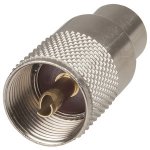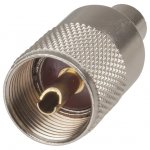I don't see it in the PL-259's that you seem to use in the US. Here we have 2 PL259's, one for RG8 and a similar one for RG58, in fact the RG58 is the same as the RG8 except it has a screw-in reducer. Don't forget to put the sleeve over the cable before you start. The inside of the cable end of the plug has a coarse thread, you cut the outer plastic back about one inch and slide it off, then undo the braid and fold it back over the outer. Cut the centre insulator carefully about 1/4" forwards of the braided section so as to expose the centre. Now insert the centre through and out of the pin and when the braid meets the end of the threaded portion, start turning. The outer braid is just the right size to be threaded through the coarse thread - it's quite tight. When it gets too tight, the centre insulator has come to the end of the inner - stop now. No soldering required. Cut the centre close to the end of the pin and solder. Trim the braid off close to the body. Done. If you want to be picky, you can shrink a sleeve over the very last bit of exposed braid.




